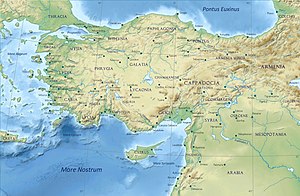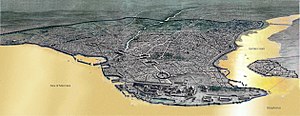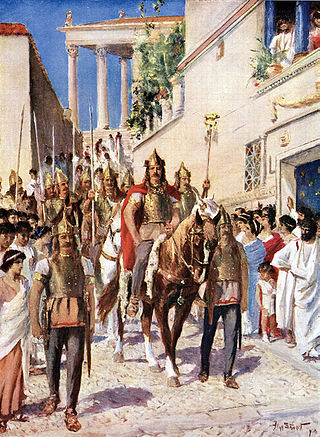
Alaric I was the first king of the Visigoths, from 395 to 410. He rose to leadership of the Goths who came to occupy Moesia—territory acquired a couple of decades earlier by a combined force of Goths and Alans after the Battle of Adrianople.
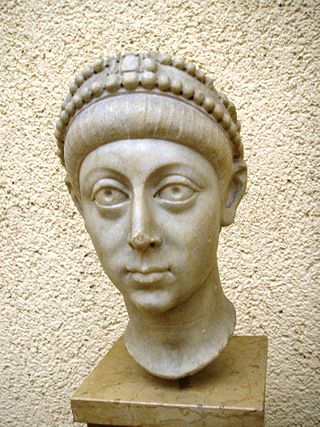
Arcadius was Roman emperor from 383 to his death in 408. He was the eldest son of the Augustus Theodosius I and his first wife Aelia Flaccilla, and the brother of Honorius. Arcadius ruled the eastern half of the empire from 395, when their father died, while Honorius ruled the west. A weak ruler, his reign was dominated by a series of powerful ministers and by his wife, Aelia Eudoxia.
The 400s decade ran from January 1, 400, to December 31, 409.
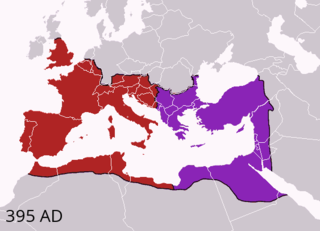
Year 395 (CCCXCV) was a common year starting on Monday of the Julian calendar. At the time, it was known as the Year of the Consulship of Olybrius and Probinus. The denomination 395 for this year has been used since the early medieval period, when the Anno Domini calendar era became the prevalent method in Europe for naming years.

Year 400 (CD) was a leap year starting on Sunday of the Julian calendar. In the Roman Empire, it was known as the Year of the Consulship of Stilicho and Aurelianus. The denomination 400 for this year has been used since the early medieval period, when the Anno Domini calendar era became the prevalent method in Europe for naming years.

Year 399 (CCCXCIX) was a common year starting on Saturday of the Julian calendar. At the time, it was known as the Year of the Consulship of Eutropius and Theodorus. The denomination 399 for this year has been used since the early medieval period, when the Anno Domini calendar era became the prevalent method in Europe for naming years.
The 390s decade ran from January 1, 390 to December 31, 399

Stilicho was a military commander in the Roman army who, for a time, became the most powerful man in the Western Roman Empire. He was of Vandal origins and married to Serena, the niece of emperor Theodosius I. He became guardian for the underage Honorius. After nine years of struggle against barbarian and Roman enemies, political and military disasters finally allowed his enemies in the court of Honorius to remove him from power. His fall culminated in his arrest and execution in 408.
Flavius Fravitta was a leader of the Goths and a top-ranking officer in the army of the Eastern Roman Empire.
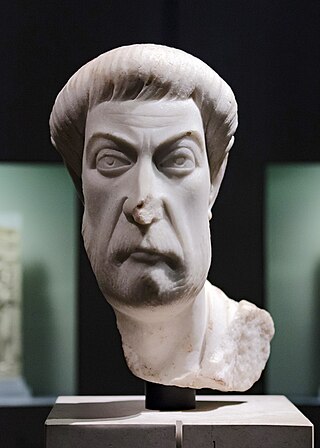
Eutropius was a fourth-century Eastern Roman official who rose to prominence during the reign of emperor Arcadius. He was the first eunuch to become a consul in the Roman Empire.
The Gothic wars or Roman–Gothic wars were a long series of conflicts between the Goths and the Roman Empire between the years 249 and 554 AD. The main wars are detailed below.
The Battle of Pollentia was fought on 6 April 402 (Easter) between the Romans under Stilicho and the Visigoths under Alaric I, during the first Gothic invasion of Italy (401–403). The Romans were victorious, and forced Alaric to retreat, though he rallied to fight again in the next year in the Battle of Verona, where he was again defeated. After this, Alaric retreated from Italy, leaving the province in peace until his second invasion in 409, after Stilicho's death.

The sack of Rome on 24 August 410 AD was undertaken by the Visigoths led by their king, Alaric. At that time, Rome was no longer the capital of the Western Roman Empire, having been replaced in that position first by Mediolanum in 286 and then by Ravenna in 402. Nevertheless, the city of Rome retained a paramount position as "the eternal city" and a spiritual center of the Empire. This was the first time in almost 800 years that Rome had fallen to a foreign enemy, and the sack was a major shock to contemporaries, friends and foes of the Empire alike.
Gainas was a Gothic leader who served the Eastern Roman Empire as magister militum during the reigns of Theodosius I and Arcadius.
Tribigild, also called Tarbigilus was an Ostrogothic general whose rebellion against the Eastern Roman Empire precipitated a major political crisis during the reign of Emperor Arcadius.
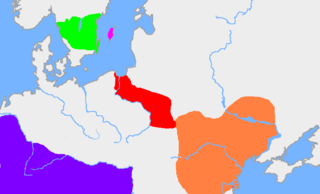
The Greuthungi were a Gothic people who lived on the Pontic steppe between the Dniester and Don rivers in what is now Ukraine, in the 3rd and the 4th centuries. They had close contacts with the Tervingi, another Gothic people, who lived west of the Dniester River. To the east of the Greuthungi, living near the Don river, were the Alans.
Odotheus was a Greuthungi king who in 386 led an incursion into the Roman Empire. He was defeated and killed by the Roman general Promotus. His surviving people settled in Phrygia.
Aurelianus was a prominent politician of the Eastern Roman Empire. He was praefectus urbi of Constantinople from 393 to 394, Praetorian prefect of the East from 399 to 400, and consul in 400. In 400, Gothic rebels under Gainas forced the emperor Arcadius to give them Aurelianus, and he was exiled; he returned to Constantinople after the defeat of the Goths later that year. He served as Pretorian Prefect to the East a second time from 414 to 416.

The Gothic War (401-403) was a war between the Western Roman Empire and the Visigoths. The commander of the Roman army was Flavius Stilicho, the Visigoths were led by Alaric. The war was fought in the north of Italy and, in addition to a number of small fights, consisted of two major battles, both of which were won by the Romans.

The revolt of Alaric I was a military conflict between the Roman Empire and a rebel army, probably composed mainly of Goths. This war consisted a number of armed conflicts in the period between 395 and 398, interspersed with periods of negotiations and sometimes even cooperation. During this war, the western and eastern parts of the Roman Empire did not always joint together because of conflicting interests. The protagonists in this conflict were the West-Roman commander-in-chief Stilicho, the Eastern-Roman prefect Rufinus, his successor Eutropius and Alaric I. The latter was an elected Gothic military leader and monarch, and later considered one of first Visigothic kings.
